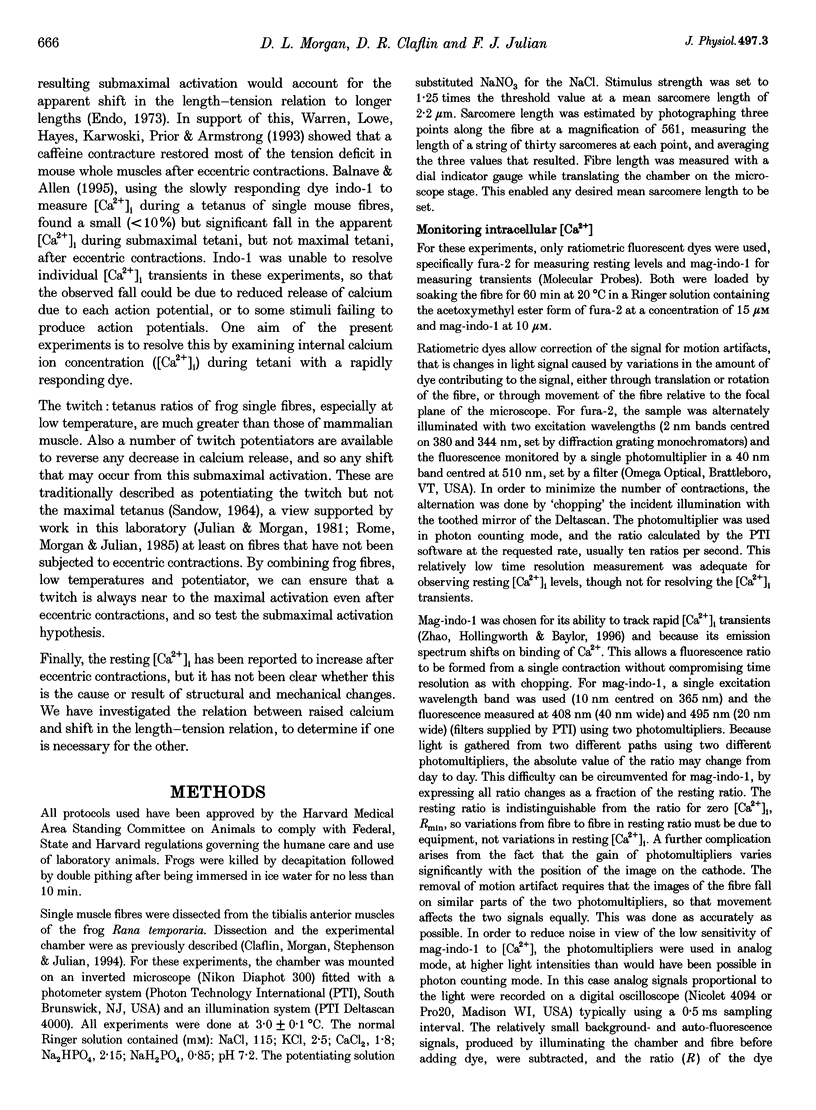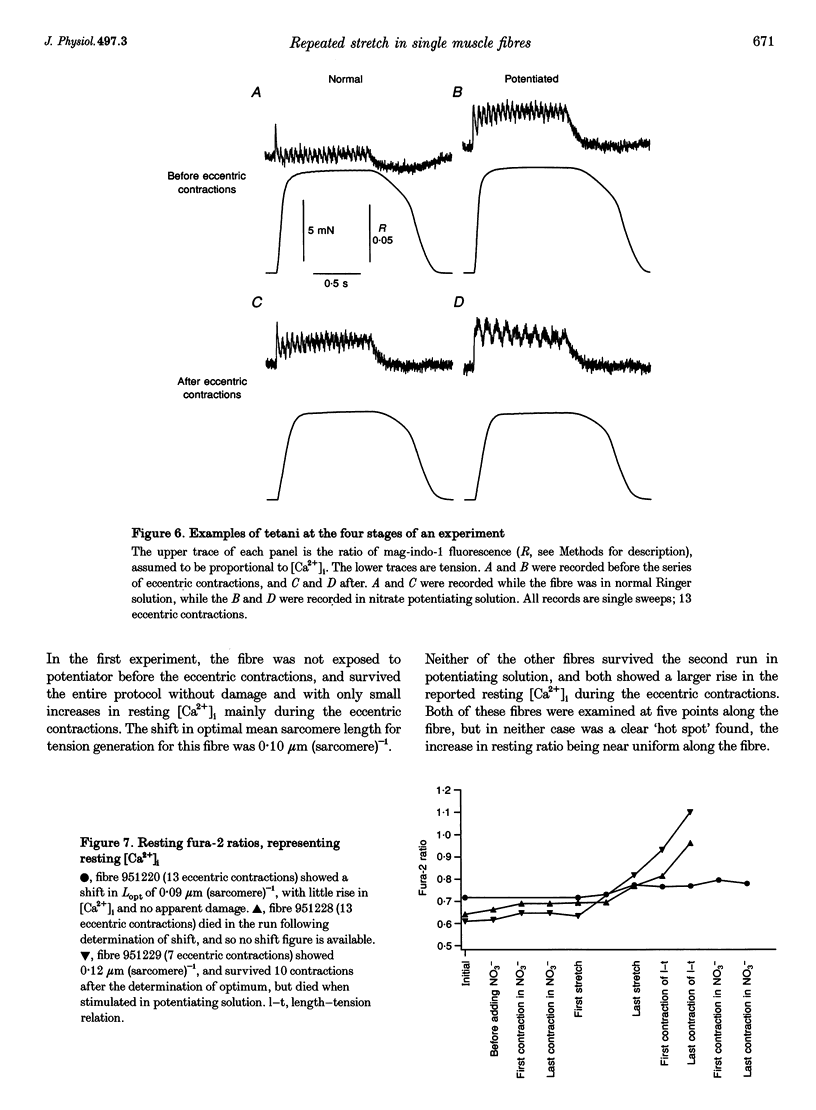Abstract
1. A series of contractions with stretches (eccentric contractions) beyond the optimal length for tension generation (optimum) were shown to induce a shift in that optimum in single muscle fibres of frog, as has been previously reported for whole muscles. Shifts averaging 0.129 micron (sarcomere)-1 or 6% were found, without apparent damage to the fibre. 2. The stiffness of fibres was found to fall during a stretch, even though tension was rising. In addition, the isometric stiffness fell as a result of a series of eccentric contractions. 3. Calcium-sensitive fluorescent dyes indicated that such contractions did not reduce the amplitude of the intracellular calcium transient, but did increase its duration. A rise in resting [Ca2+] was found to accompany damage, but not necessarily the shift in optimum. 4. The twitch potentiator nitrate was shown to increase myoplasmic [Ca2+] during twitch and tetani, but not to reverse the shift in optimum length due to eccentric contractions. Both eccentric contractions and twitch potentiation reduced the maximum stimulation rate to which a fibre could respond with propagated action potentials. 5. These results exclude reduced myoplasmic [Ca2+] as the cause of the shift in optimum length in this preparation.
Full text
PDF









Selected References
These references are in PubMed. This may not be the complete list of references from this article.
- Armstrong R. B. Mechanisms of exercise-induced delayed onset muscular soreness: a brief review. Med Sci Sports Exerc. 1984 Dec;16(6):529–538. [PubMed] [Google Scholar]
- Armstrong R. B., Ogilvie R. W., Schwane J. A. Eccentric exercise-induced injury to rat skeletal muscle. J Appl Physiol Respir Environ Exerc Physiol. 1983 Jan;54(1):80–93. doi: 10.1152/jappl.1983.54.1.80. [DOI] [PubMed] [Google Scholar]
- Balnave C. D., Allen D. G. Intracellular calcium and force in single mouse muscle fibres following repeated contractions with stretch. J Physiol. 1995 Oct 1;488(Pt 1):25–36. doi: 10.1113/jphysiol.1995.sp020943. [DOI] [PMC free article] [PubMed] [Google Scholar]
- Brown L. M., Hill L. Some observations on variations in filament overlap in tetanized muscle fibres and fibres stretched during a tetanus, detected in the electron microscope after rapid fixation. J Muscle Res Cell Motil. 1991 Apr;12(2):171–182. doi: 10.1007/BF01774036. [DOI] [PubMed] [Google Scholar]
- Claflin D. R., Morgan D. L., Stephenson D. G., Julian F. J. The intracellular Ca2+ transient and tension in frog skeletal muscle fibres measured with high temporal resolution. J Physiol. 1994 Mar 1;475(2):319–325. doi: 10.1113/jphysiol.1994.sp020072. [DOI] [PMC free article] [PubMed] [Google Scholar]
- Davies C. T., White M. J. Muscle weakness following eccentric work in man. Pflugers Arch. 1981 Dec;392(2):168–171. doi: 10.1007/BF00581267. [DOI] [PubMed] [Google Scholar]
- HUXLEY A. F. Muscle structure and theories of contraction. Prog Biophys Biophys Chem. 1957;7:255–318. [PubMed] [Google Scholar]
- Huxley H. E., Stewart A., Sosa H., Irving T. X-ray diffraction measurements of the extensibility of actin and myosin filaments in contracting muscle. Biophys J. 1994 Dec;67(6):2411–2421. doi: 10.1016/S0006-3495(94)80728-3. [DOI] [PMC free article] [PubMed] [Google Scholar]
- Julian F. J., Morgan D. L. Tension, stiffness, unloaded shortening speed and potentiation of frog muscle fibres at sarcomere lengths below optimum. J Physiol. 1981;319:205–217. doi: 10.1113/jphysiol.1981.sp013902. [DOI] [PMC free article] [PubMed] [Google Scholar]
- Katz B. The relation between force and speed in muscular contraction. J Physiol. 1939 Jun 14;96(1):45–64. doi: 10.1113/jphysiol.1939.sp003756. [DOI] [PMC free article] [PubMed] [Google Scholar]
- Morgan D. L. An explanation for residual increased tension in striated muscle after stretch during contraction. Exp Physiol. 1994 Sep;79(5):831–838. doi: 10.1113/expphysiol.1994.sp003811. [DOI] [PubMed] [Google Scholar]
- Morgan D. L. New insights into the behavior of muscle during active lengthening. Biophys J. 1990 Feb;57(2):209–221. doi: 10.1016/S0006-3495(90)82524-8. [DOI] [PMC free article] [PubMed] [Google Scholar]
- Morgan D. L. Separation of active and passive components of short-range stiffness of muscle. Am J Physiol. 1977 Jan;232(1):C45–C49. doi: 10.1152/ajpcell.1977.232.1.C45. [DOI] [PubMed] [Google Scholar]
- Newham D. J., Jones D. A., Clarkson P. M. Repeated high-force eccentric exercise: effects on muscle pain and damage. J Appl Physiol (1985) 1987 Oct;63(4):1381–1386. doi: 10.1152/jappl.1987.63.4.1381. [DOI] [PubMed] [Google Scholar]
- Newham D. J., McPhail G., Mills K. R., Edwards R. H. Ultrastructural changes after concentric and eccentric contractions of human muscle. J Neurol Sci. 1983 Sep;61(1):109–122. doi: 10.1016/0022-510x(83)90058-8. [DOI] [PubMed] [Google Scholar]
- Piazzesi G., Francini F., Linari M., Lombardi V. Tension transients during steady lengthening of tetanized muscle fibres of the frog. J Physiol. 1992 Jan;445:659–711. doi: 10.1113/jphysiol.1992.sp018945. [DOI] [PMC free article] [PubMed] [Google Scholar]
- Rome L. C., Morgan D. L., Julian F. J. Stimulation rate, potentiators, and sarcomere length-tension relationship of muscle. Am J Physiol. 1985 Nov;249(5 Pt 1):C497–C502. doi: 10.1152/ajpcell.1985.249.5.C497. [DOI] [PubMed] [Google Scholar]
- SANDOW A. POTENTIATION OF MUSCULAR CONTRACTION. Arch Phys Med Rehabil. 1964 Feb;45:62–81. [PubMed] [Google Scholar]
- Sugi H., Tsuchiya T. Stiffness changes during enhancement and deficit of isometric force by slow length changes in frog skeletal muscle fibres. J Physiol. 1988 Dec;407:215–229. doi: 10.1113/jphysiol.1988.sp017411. [DOI] [PMC free article] [PubMed] [Google Scholar]
- Talbot J. A., Morgan D. L. Quantitative analysis of sarcomere non-uniformities in active muscle following a stretch. J Muscle Res Cell Motil. 1996 Apr;17(2):261–268. doi: 10.1007/BF00124247. [DOI] [PubMed] [Google Scholar]
- Tsuchiya T., Sugi H. Muscle stiffness changes during enhancement and deficit of isometric force in response to slow length changes. Adv Exp Med Biol. 1988;226:503–511. [PubMed] [Google Scholar]
- Warren G. L., Lowe D. A., Hayes D. A., Karwoski C. J., Prior B. M., Armstrong R. B. Excitation failure in eccentric contraction-induced injury of mouse soleus muscle. J Physiol. 1993 Aug;468:487–499. doi: 10.1113/jphysiol.1993.sp019783. [DOI] [PMC free article] [PubMed] [Google Scholar]
- Wood S. A., Morgan D. L., Proske U. Effects of repeated eccentric contractions on structure and mechanical properties of toad sartorius muscle. Am J Physiol. 1993 Sep;265(3 Pt 1):C792–C800. doi: 10.1152/ajpcell.1993.265.3.C792. [DOI] [PubMed] [Google Scholar]
- Zhao M., Hollingworth S., Baylor S. M. Properties of tri- and tetracarboxylate Ca2+ indicators in frog skeletal muscle fibers. Biophys J. 1996 Feb;70(2):896–916. doi: 10.1016/S0006-3495(96)79633-9. [DOI] [PMC free article] [PubMed] [Google Scholar]


